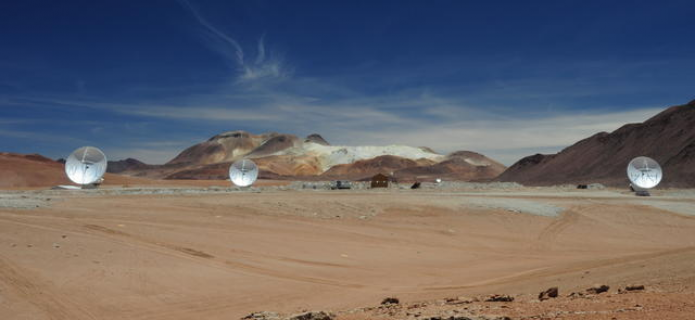Closing the loop for ALMA
Three antennas working in unison open new bright year for revolutionary observatory
The Atacama Large Millimeter/submillimeter Array (ALMA) has passed a key milestone crucial for the high-quality images that will be the trademark of this revolutionary new tool for astronomy. Astronomers and engineers have, for the first time, successfully linked three of the observatory's antennas at the 5000-meter elevation observing site in northern Chile. Having three antennas observing in unison provides the missing link to correct errors that arise when only two antennas are used, thus paving the way for precise images of the cool Universe at unprecedented resolution.
On 20 November 2009 the third antenna for the ALMA observatory was successfully installed at the Array Operations Site, the observatory’s “high site” on the Chajnantor plateau, at an altitude of 5000 meters in the Chilean Andes. Later, after a series of technical tests, astronomers and engineers observed the first signals from an astronomical source making use of all three 12-meter diameter antennas linked together, and are now working around the clock to establish the stability and readiness of the system.
“This is a moment that we have been looking forward to for a very long time”, says Richard Hills, the ALMA Project Scientist. “Now we can finally say that we have put together a full set of all the components of ALMA as a complete system and what’s more, it works! It is particularly pleasing that this was achieved within a few days of the target date, set over a year ago, for reaching this point. We will be looking forward eagerly to more excitement over the next few months as we add more antennas and receivers to the array and start to make our first images with ALMA.”
The successful linking of the antenna trio was a key test of the full electronic and software system now being installed at ALMA, and its success anticipates the future capabilities of the observatory. When complete, ALMA will have at least 66 high-tech antennas operating together as an “interferometer”, working as a single, huge telescope probing the sky in the millimeter and submillimeter wavelengths of light. The combination of the signals received at the individual antennas is crucial to achieve images of astronomical sources of unprecedented quality at its designed observing wavelengths.
The three-antenna linkup is a critical step towards the observatory’s operations as an interferometer. Although the first, successful measurements employing just two antennas were obtained at the ALMA high site from October 2009 and demonstrated the excellent performance of the instruments, the addition of the third antenna is a leap of vital importance into the future of the observatory. This major milestone for the project is known as “phase closure” and provides an important independent check on the quality of the interferometry. Indeed, the use of a network of three (or more) antennas in an interferometer gives astronomers control over possible features which degrade the quality of the image, arising due to the instrument or to atmospheric turbulence. By comparing the signals received simultaneously by the three individual antennas, these unwanted effects can be cancelled out, which is completely impossible using only two antennas.
To achieve this crucial goal, astronomers observed the light coming from a distant extragalactic source, a quasar with the prosaic name 1924-292, which is well known to astronomers for its bright emission in the millimeter/submillimeter wavelength range probed by ALMA. The stability of the signal measured from this object shows that the antennas are working impressively well.
“This result, combining the individual signals received by the first three antennas installed at the Chajnantor site, is a milestone for the observatory”, comments Thijs de Graauw, ALMA Director. “We will have many more antennas installed over the coming months, allowing astronomers to start producing early scientific results with the ALMA system around 2011. The interferometer will then steadily grow over the following years to reach its full scientific potential, with at least 66 antennas.”
ALMA, an international astronomy facility, is a partnership of Europe, North America and East Asia in cooperation with the Republic of Chile.
More Information
The Atacama Large Millimeter/submillimeter Array (ALMA), an international astronomy facility, is a partnership of the European Organisation for Astronomical Research in the Southern Hemisphere (ESO), the U.S. National Science Foundation (NSF) and the National Institutes of Natural Sciences (NINS) of Japan in cooperation with the Republic of Chile. ALMA is funded by ESO on behalf of its Member States, by NSF in cooperation with the National Research Council of Canada (NRC) and the Ministry of Science and Technology (MOST) in Taiwan and by NINS in cooperation with the Academia Sinica (AS) in Taiwan and the Korea Astronomy and Space Science Institute (KASI).
ALMA construction and operations are led by ESO on behalf of its Member States; by the National Radio Astronomy Observatory (NRAO), managed by Associated Universities, Inc. (AUI), on behalf of North America; and by the National Astronomical Observatory of Japan (NAOJ) on behalf of East Asia. The Joint ALMA Observatory (JAO) provides the unified leadership and management of the construction, commissioning and operation of ALMA.
ALMA, the largest astronomical project in existence, is a revolutionary telescope, comprising an array of 66 giant 12-meter and 7-meter diameter antennas observing at millimeter and submillimeter wavelengths. ALMA will start scientific observations in 2011.
Contacts
William Garnier
ALMA Education and Public Outreach Officer
[email protected]
+56 2 467 61 19
